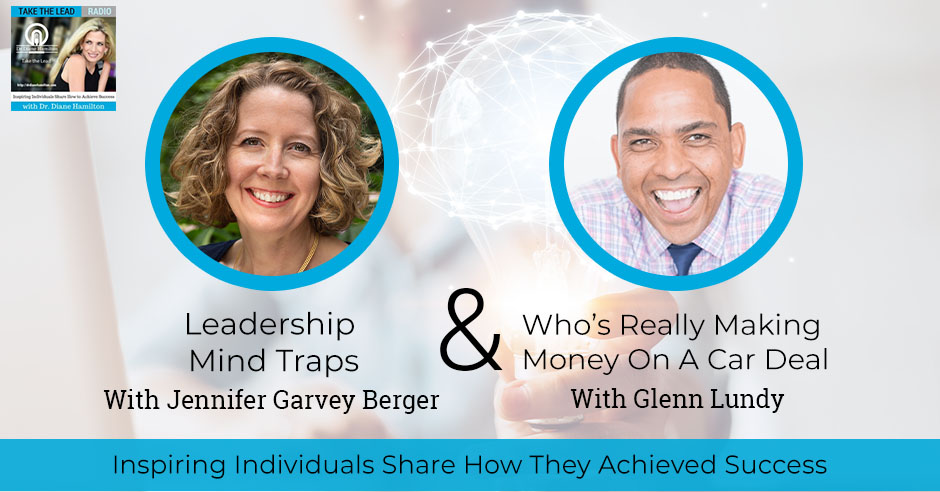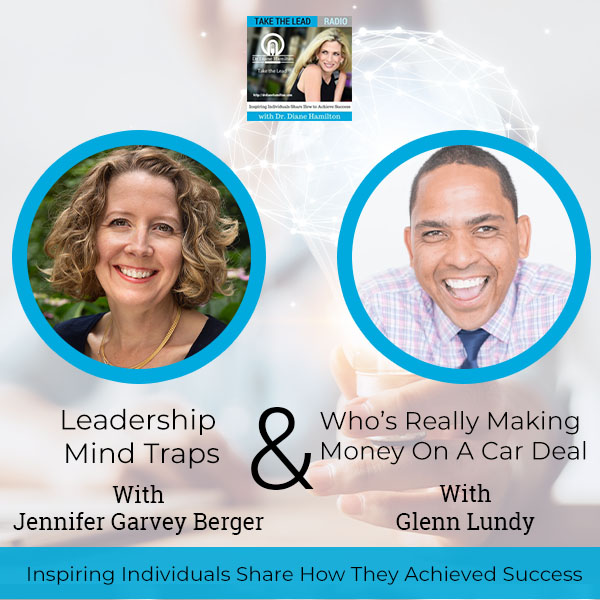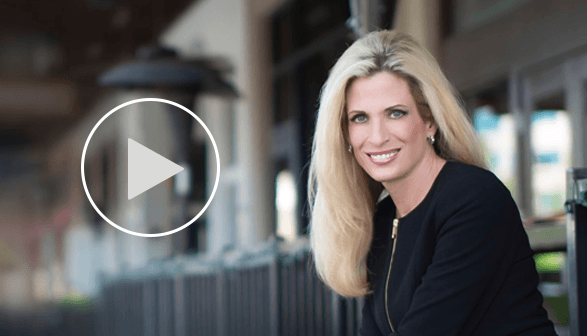Many people view leadership as a set of lessons to be learned, a group of qualities, or a demanding responsibility. However, becoming a leader is not about completing a course but being transformed. Leadership grows, and we need to cultivate as much of it as we can in these complex and often-troubled times. Joining Dr. Diane Hamilton on today’s podcast is development coach and author Jennifer Garvey Berger. The CEO of Cultivating Leadership, Jennifer shares how she got into the leadership and coaching world and talks about the pervasive leadership mind traps that so many leaders get themselves into and how to get over them.
The product of a black father and a white mother who split up when he was eleven, Glenn Lundy grew up in two cultures. This got him spending most of his childhood until early into his twenties having a hard time identifying who he is and where he belongs. Many more challenges later that got him hitting the proverbial rock bottom, Glenn dove into self-development and worked his way up from being a salesperson all the way to the top. Today with Dr. Diane Hamilton, Glenn talks about his Facebook Live show called #RiseAndGrind, his experience in the automotive industry that led to be the pioneer of the 800% Club, and who’s really making money on a car deal.

I’m so glad you joined us because we have Jennifer Garvey Berger and Glenn Lundy here. Jennifer is a CEO at Cultivating Leadership. She’s the author of multiple books including the Unlocking Leadership Mindtraps. Glenn is the pioneer of the 800% Club. He’s the host of #RiseAndGrind. He’s an author and speaker. We’re going to talk to both of them about leadership, success, podcasting and so much more.
Watch the episode here
Listen to the podcast here
Leadership Mind Traps With Jennifer Garvey Berger
I am here with Jennifer Garvey Berger who is CEO at Cultivating Leadership. She’s the author of multiple books including Changing on the Job: Developing Leaders for a Complex World and coauthored Simple Habits of Complex Times: Powerful Practices for Leaders and Executive Coaching: Practices and Perspectives. I’m anxious talking to you about unlocking leadership mind traps. It’s nice to have you here, Jennifer.
Thanks. It’s wonderful to be here.
I was looking forward to this because we had both shared the stage on events for Novartis, now that everything’s done through Zoom. I know every year in September, Novartis brings in some of the most amazing speakers to help develop curiosity. What you do is particularly fascinating because you look at some of the things that keep people back, as my research does with curiosity. I want to give a little background on you. I know you got a PhD and a Master’s from Harvard. I want to lead up to what made you want to get into this leadership and coaching world.
We all have our own funny pathway in. When I was doing the doctorate, I got interested in this question of adult development. How do grownups transform themselves? How do they transform their capacity to handle the complexity, the ambiguity and the change in the world? That became a passion of mine. For a while, I used that passion to help teachers think about teaching children in new ways and how principals lead schools in new ways. As time passed, I edged more from the education world into the business world. If you care about the learning of grownups, most grownups do most of their learning in their family lives where we don’t have a lot of access and at work. These are the unifying adult experiences. If we can change what happens for grownups at work, we have a chance of helping whole generations of people get better able to handle the world we’re growing into.
That’s important and having taught many courses, it’s fascinating what we teach at these different universities and what they don’t teach, what people should be getting at home and school. I speak a lot on soft skills and emotional intelligence. My dissertation was on emotional intelligence. I know you had written yours on adult development. It’s a fascinating look at what sparks people’s desire to learn more and advance. My research was looking at what holds people back from being curious. You look at some of the mind traps that can inhibit leaders. Let’s talk a little bit about that because in order for people to be successful, you have to look at what holds you back first to move forward. Was that your thought of what unlocking leadership mind traps was about?
The thing that happened to me is that I’ve been teaching leaders about how to handle complexity and how to grow better able to handle this world for years. I work with smart, passionate and committed grownups. These people are switched on. They totally understood what to do, but there was some way that they would like to come to a fork in the road in a conversation. They knew that the right thing to do is to turn left and they always turn right. It was like this crazy pattern where people were behaving exactly the opposite way than we had agreed that they would behave, than they promised they would behave, than they wanted to behave. These were leaders across industries, all over the world. I got super curious about, what is that? What’s going on about that that’s getting in their way? As I synthesize those particular traps, I found that they’re all psychobiological. They’re wired in. We’ve evolved to have them in these clever ways that once were useful, and now not so much.
It’s interesting because all of that ties into that status quo thinking that we’re trying to get out of. I’ve seen some of the research that they’ve done that show people will go along with what everybody else is doing because it’s comfortable. Is that what you find a lot of companies do? It’s comfortable. It’s the old way of doing things. It’s hard to shake that.
[bctt tweet=”The human mind is wired for narrative. We are wired to tell stories around the campfire. ” username=””]I’m not even sure it’s comfortable. A lot of the leaders I work with are in real pain doing the thing that they’ve always done. They have created a whole set of assumptions, rules or identities for themselves that mean they can’t escape who they’ve been in order to reach for who they could be.
You said that there are five of these pervasive mind traps. I want to go through them because they’re important. Let’s start with the desire for simple stories. What do you mean by that? How is that a mind trap?
The human mind is wired for narrative. We love stories early in our lives. Before we become verbal, we can figure out plots with beginnings, middles, ends and feel surprised when something unexpected happens. We are wired to tell stories around the campfire. It’s how we create culture, religions, organizations, cities and country systems. To be transmissible, those stories have particular rhythms. They have particular stock characters. They have particular sets of relatively simple cause and effect. The thing that we don’t know is that we’re telling ourselves those stories all the time. Our brain is filling missing details. Our brain is lying to us all the time. We are constantly reinforcing whatever cardboard cutout story we have about other players in our lives. We’re forgetting that the villain in our story is the hero in her story. She has a different story than we have about what’s going on. We get trapped by our stories and then by the mechanisms we use to reinforce those stories to prove that they’re true.
That’s great to talk about. My book is about bias and perception, and the title is The Power of Perception. I write about some of these things that you’re talking about. We do this confirmation bias and all these things that force us to get this story that we’ve told ourselves to be true because we want it to be true. It’s challenging. When I was looking at perception, I was looking at it as a process and looking at it as a combination of IQ, EQ, Emotional Quotient and CQ for Curiosity and Cultural Quotient and how they all come together. In what you’ve seen, how do we overcome and realize that? I know through empathy you can ask questions through curiosity and develop a sense of putting yourself in somebody else’s story, and seeing it from their perception. Do you have any other things you’d like to add on how do we get over that?
For me, as for you, curiosity is basically the engine of growth. If we can find our way to becoming more curious, we begin to grow. The problem is that these mind traps eliminate our curiosity. Each of them is a curiosity quieter. Each of them is an enemy of curiosity in its own way. One of the things we know about adult development is the way we grow is to see something that we were previously blind to. We were not only blind to, but we were acting out unselfconsciously. My offering of these ideas is so that if I can carry the notion that I might be telling a simple story, when one comes up and I’m telling myself a simple story, I can suddenly have the question, “Is this a simple story? Do I need to be doing a different thing here? Am I convincing myself of this thing?”
I can ask questions about the context, “Is this a complex context? If it is and I have a simple story, then I know that I’m off the mark and I know I’m in a trap.” By asking a few little questions about what’s going on for me, I can grow. Particularly if I have colleagues or teammates who are also on the same path, they can see when I’m in a simple story much faster than I can see when I’m in a simple story. If we agree these are mind traps we’re looking out for, we can begin to help each other avoid them.
You don’t know what you don’t know. You have this voice that tells you certain things in your head. In the research I did on curiosity, the four things that hold people back from being curious are fear, assumptions, technology and the environment. The assumptions are what you’re talking about here, what we tell ourselves are the story.
The way we’re crafting even our perception of the world comes from the stories that we’re telling ourselves about it.

Leadership Mind Traps: The way we’re crafting our perception of the world comes from the stories that we’re telling ourselves about it.
You say the second thing of these five mind traps is the sense that we’re right. We all hope we’re right because you assume you’re right until somebody points out that you’re wrong in some instances. Nobody wants to think they’re wrong. How do you get over that sense that everything you’re thinking is correct because you don’t know better?
The thing that helps me and my clients is the research on rightness that shows that the feeling that “I’m right about this” is an emotion and it’s precognitive. We have the sense that we’re right, then our cognition kicks in and it convinces us. We then build an argument. We see this in political discourse all the time. We see it in all this other psychological research that shows if you give people with strong opinions more data, then after they interact with the data, they believe their previous opinion harder. No matter which direction the data pointed in, they believe what they used to believe harder than they did before. This whole question that we’re designed to amplify our sense that whatever our first idea was is the right one.
When people find out that that’s an emotional response and not a cognitive response, then suddenly they learned to not trust it so much. I teach my clients to notice what does certainty feels like in your body? What cues can you look for? As soon as you feel certain about something in complexity, you know that we’re cutting out heaps of pivotal data. There’s no such thing as certainty and complexity. It’s in the very nature of a complex world, you can’t be certain about things. As soon as you notice the emotion of certainty in yourself, you can begin to open yourself up and ask questions, and see if you can generate the curiosity that is the antidote to certainty.
What we tell ourselves can set up whether we’re successful in our teams or working in a global environment. You’ve touched on the next area. It’s the desire to get along with others in our group. Is it getting along with others or the desire to get on with them? It was interesting that you had the word desire in there.
It is that we are wired to be safe inside a group that we’ve chosen or that we somehow orient to. We’re so wired to that tribal thing that anything that puts that at risk is experienced in our brains and exactly the same way that physical pain is experienced in the brain. You can’t tell in a brain scan the difference between someone who’s hurt his ankle and someone who’s hurt his feelings. Those are the same in the brain. That was lifesaving. We needed to learn to get along with each other and to live in tribes because we’re too small, too weak, too slow to survive without each other. Our bodies evolved to make it so that we would orient to that thing, our connection with one another, as a physical need that we have.
We don’t know that that’s happening. That often happens underneath the surface of our consciousness. We don’t even notice necessarily that we’re changing our approach or our minds to go along with the group, nor do we notice that we’re amplifying our differences between anybody we think of as not in my tribe. We amplify those differences so that we are quickly figuring out how to filter a friend or enemy. That changes the thoughts that are available to us. That changes what we know about the world.
It’s interesting as you age, you can look back and you go, “I’ve changed somewhat.” When you’re dealing with different generations, it’s a challenge to explain. Maybe later, you’ll see it a different way or maybe you won’t. One of my adult student’s daughter was going into a college program and she had to write an essay. She asked me to look at her essay because they asked her to have one person to review it. It was so interesting to look at what she wrote about because it was a lot to do with your fourth factor here of what you looked at as a mind trap. It was about her idea of being out of control due to COVID. She felt scared and out of place. They asked her to write about a time where she didn’t feel comfortable or felt scared. You say we have a fixation with control and this is a time that everybody’s feeling a little of that. How do we get out of feeling that sense that we need to control or living with the fact that we can’t control everything?
[bctt tweet=”If we can find our way to becoming more curious, we begin to grow.” username=””]The pain that we’re feeling now is the realization that the control we thought we had was always an illusion. We’re not less in control than we used to be. We just notice that we’re less in control than we used to be noticing. It’s a reframing. How do we reframe what it is to be in control? Our reflex here is to think, “I need to figure out what’s the part of this I can control.” I orient around that. I incentivize that. I figure out how to get more of that in the world. If I’m a leader in an organization I figure out, how do I measure it? How do I orient people around it? How can I be sure it will happen?
Most of the things we care about are complex phenomena. We care about how do our kids grow up and thrive in the world. We might orient towards controlling what school they go to or how many extracurricular activities they have. This is not the same thing at all. We might get fixated on the one path. In that fixation, we might ruin the very outcome that we seek. This happens in organizations all the time. If I want psychological safety in my team, then I fixate on I hear interrupting interferes with psychological safety, so there’s no interrupting. We’re going to focus on interrupting. You get this stilted and uncreative conversation pattern because people are terrified of doing this thing. They feel less safe because they’re trying hard to do this thing that’s supposed to make them safer.
It’s a time where people are so confused and there’s a sense of, we thought we had control, but it was an illusion. We are always on this quest to have a sense of safety and all that. It is interesting to look at the way you look at these different traps that we fall into. The last one is even an interesting thing in how you came about your different five mind traps. In the last one, you said that there was a constant quest to protect and defend our egos. First, I want to hear your explanation for why do we do that and what problems does that cause?
Many people react to the word ego. You could also think about it as your identity. In ego, it’s technically not the way we use it in slang like, “She has a big ego.” It’s that piece of ourselves that is the interface between our inner world and our connection with others. There’s that thing that we’re trying to be, that we are trying to show, “These are my values. These are the things I hate and never want to be.” Each of us, without noticing it, is on a constant quest to convince ourselves and other people that we are living by these values and that we are never going to be like those terrible things.
As we’re here curating ourselves for others and for our own self-perception, that builds a trap around us because the person we have been up until now interferes with the person we’re going to be next. The person we’re going to be next might have to soften on some of those protections about what I want to put in the world. There’s this second thing psychologists have found, which is this idea that we tend to believe that we’ve changed a lot in the past, and that we’re not going to change in the future. They call it the end of history illusion like, “History stops now. This is the end of history. I have arrived.” That sense of arrival, the sense that we are not constantly remaking ourselves gets in the way of our capacity to remake ourselves and to grow bigger and better able to handle the crazy world we live in.
That was the end at any point where you’ve reached the pinnacle of success or at the end or whatever it is. It will be boring if nothing ever changed after that. I’m glad that it doesn’t work out that way. I was fascinated by your work and it ties in well to the research that I do with curiosity and perception. That’s why I was excited to have you on the show. A lot of people would love to read your books and find out more about you. Is there a website or something you’d want to share?
I am part of a little leadership consultancy called Cultivating Leadership. You can read more about me and my work and my many brilliant colleagues and their work in this funky little organization we started. Our website is easily CultivatingLeadership.com. We have a ton of free videos, papers, and little things that leaders can use for themselves, for their teams, etc. We can get these ideas into the hands of the people who want to use them, who are invested in growing themselves, and in growing their teams and their organizations so that their communities can thrive.

Leadership Mind Traps: There’s no such thing as certainty and complexity. It’s in the very nature of a complex world; you can’t be certain about things.
I know you do some amazing stuff there and we have some of the same clients. You also work with Google, Microsoft, Wikipedia, Oxfam. I know we both worked with Novartis. I was looking at your list and it’s quite impressive. Everybody should take some time to check out your site, but this was interesting. Thank you, Jennifer. I enjoyed our conversation and everybody checks out your information.
Long may we unite in the quest to help people ignite their curiosity because that will help us all live better in a world that’s changing fast. Thank you for having me.
You’re welcome. This was fun.
Who’s Really Making Money On A Car Deal With Glenn Lundy
I am here with Glenn Lundy who is the pioneer of the 800% Club, host of #RiseAndGrind, author and speaker. It’s nice to have you here, Glenn.
It is an absolute honor and a privilege. I appreciate you sharing this space and time with me.
I was looking forward to it. We have some of the things in common that we do a lot of things. One thing I want to do before we get into some of the things you’re working on is I like to get the backstory on people. What led to you getting to this place in your life? If you can give us a little backstory.
[bctt tweet=”The pain that we’re feeling now is the realization that the control we thought we had was always an illusion.” username=””]I grew up in Flagstaff, Arizona. I am mixed. My dad is black and my mom is white. They got divorced when I was about eleven years old. The interesting part about that is my dad got remarried and he married a black woman, and my mom got remarried and married a white guy. They moved into the same apartment complex, Greenlaw Garden Apartments. My mom and her new husband moved into apartment 28 with me and my sister. My dad and his new wife moved into apartment 30. It was him, her and then she had four kids that she brought to the relationship. Literally two doors apart from each other, I had these completely different cultures. It was amazing.
It was wild. Every stereotype that you could think of existed in my dad’s house, collard greens, fried chicken, drinking Kool-Aid, listening to gospel music, Motown, and hip hop. It was this loud, wild, crazy, and lots of sports, TV in every room. Mom’s house was more rock and roll, country music, hanging out at the bowling alley, and those types of things. I grew up in these two cultures, which looking back, I’m thankful for it because it helps me to see through different people’s eyes. At the time, as I’m developing as a child, it was a difficult season for me because my skin was too dark to be considered white. It was too light to be considered black.
I spent most of my middle school and high school years, and early into my twenties having a hard time identifying with who I am and where I belong. I got along with all people on a surface level. I was smart. I had a great mouthpiece and so I could get along with people on the surface, but I didn’t have any deep, lasting connections or relationships for a long time. I struggled with that into my twenties. I got into the car business when I was twenty years old. I had my first daughter. I now have going on my eighth kids. My wife is pregnant with number eight.
First of all, my children, I had her when I was twenty. I went into the workforce. I started selling cars. My career went well. I went from sales to growing into leadership positions in the auto world rather quickly, but outside of work, my life was a mess. My daughter’s mother and I split up when she was two. My daughter, I didn’t make her a priority at the time. Work was the main priority, followed by partying and things like that were the second priority. When my daughter was six years old, I lost custody of her. She was taken away from me custody-wise. That sent me into a bit of a spiral where I ran away from all of the people that I knew and all of the things that I knew.
I blamed everyone else. I had this victim mentality. I had burned a lot of bridges and I ran as far as I could for as long as I could until ultimately I ended up landing on the beaches of San Diego. I found myself homeless for a season. Homelessness led to hopelessness, which led to a deep depression, which led to suicidal thoughts, which led to ultimately a suicide attempt. I tried to take my own life during that season. Clearly, I was unsuccessful. It would be weird if I was successful with that and I’m being interviewed. That would be a different type of show.
That moment, hitting that proverbial rock bottom and coming out of that. I went through a season of trying to get an understanding of self, understanding of the spiritual world, understanding of my place and my purpose. Once I hit that rock bottom, I realized that I was blaming everyone else, but it was me that was the constant in every situation. You take yourself wherever you go. I started to realize that I’ve created this and this is not a life I want to live. If I created this, then I should be able to create the opposite. I should be able to create abundance and those types of things.
I started seeking understanding. I dove into self-development. I started finding some mentors and learning more about my mind, frequencies and spirituality. I studied all types of different religions and things like that. That journey led me to land in Kentucky where I am now. I landed in Kentucky with $1,500 cash and a suitcase. I didn’t know anybody and started over. From there, I did some odd jobs and ran a small business for a while. I met my now wife. She got pregnant quickly. It seems to be a trend for me.

Leadership Mind Traps: You can’t tell in a brain scan the difference between someone who’s hurt his ankle and someone who’s hurt his feelings.
She got pregnant and it was like, “Glenn, here we are again. This is where you were ten years ago. We’re going to do things differently this time. We’re going to make her a priority. You’re going to make Leslie a priority. We’re going to make this kid a priority. We can get back into the automotive industry, but we have to understand that we have a responsibility to change it, not let it change us.” I went back into automotive back in 2011. I had tremendous success at a small dealership in Paris, Kentucky. I started as a salesperson and worked my way all the way to the top. Now I’ve spent the last few years working with and training owners, general managers and leaders in the auto industry all across the nation. That’s the backstory.
It’s interesting that you’d end up in Kentucky. That’s not exactly Arizona, California location. My husband did his residency there. I hear it’s beautiful. I’ve never been there. How did you get to Kentucky?
At one point, I got a job for a company called 2020 Companies. That company sent me around the United States opening sales offices. I spent three weeks in Lexington, Kentucky opening sales offices. While I was out here, being a car guy, one of the things that you do is you always look at license plate frames because it tells you who the good dealer is. I kept looking at license plate frames and all the license plate frame said Glenn on it because there’s a big Glenn Auto Mall out here. It was like Glenn everywhere. I kept seeing these huge billboards for Lundy’s Catering. The largest catering company in Lexington is Lundy’s Catering. It was like Glenn and Lundy were screaming at me.
While I was out here, I met a young man named Aaron Jones. He’s a great kid. He and I hung out. When I went back to San Diego, went through that whole season. He happened to give me a call and he was like, “What are you doing with your life?” I’m like, “Brother, absolutely nothing.” He said, “I’m going to get my own place. I need a roommate. You should come to Kentucky.” I came out here and slept on his sister’s couch for four months while he and I put together enough money to get a place. Now we took off from there.
It sounds like you’ve taken off from there. I’ve heard great things about your Facebook Live show. How have you come up with #RiseAndGrind? Why Facebook? Why put it there?
As I was creating success in the auto world with our dealership, we were doing a lot of Facebook. A lot of Facebook marketing, a lot of Facebook with my team, training them on a particular post and how to generate organic reach on Facebook, Facebook Marketplace, and a lot of things. We were spending a lot of time on Facebook. Because of the success that we were having at the dealership, and because we were innovative and unique in the way we were doing things, we started to draw a lot of attention. We naturally built this huge following on Facebook through the success of the dealership. We started attracting some talented people to come work for me. Clients and customers, we’re starting to develop stronger relationships with them.
It was working for us. I wanted to create a space. I remember getting frustrated at some of the negativity that can be found on social platforms. I was complaining about it and I don’t like to be a complainer. I was like, “Let’s not complain about the negativity. Let’s do something about it.” I decided to create a space filled with motivation, education and inspiration. For at least 30 minutes a day, we could block out all of the division, the politics, the violence and all of that. I figured the best time to do that is first thing in the morning because I foundationally believe that if we can change the way people start their day, it makes a massive impact on their life.
[bctt tweet=”You take yourself wherever you go.” username=””]What days do you air?
Monday through Friday.
At what time?
5:30 AM Eastern.
I’m almost up that early on here. You do get the early risers. They can watch it later, I assume.
I’d say only about 4% to 5% of our viewers watch it live at 5:30 and thousands of people watch it as the day continues on. We rerun it as live again at 8:30 AM Eastern. We have some software that allows us to run it live again. We run it as live twice a day and then it stays up all day. It’s been great. It started with a show and creating that safe place. People started watching. The people that were watching were like, “We need our own group that’s nothing but motivation, education, inspiration.” We created a group that now has 30,000-plus active members. From there, they were like, “We need T-shirts and clothes.” Now we have a clothing line with T-shirts, hats and hoodies, and then people wanted live events. We started creating live events and 300, 400 people showed up for motivation, education, inspiration. Now here we are a few years in, we’ve done 734 episodes. We interview guests on Fridays. We’ve had some big-name guests that have been on the show. We had Eric Thomas, Grant Cardone and Dave Meltzer. It’s been a fun journey. It’s been cool.
It is fun to get to chat with people who are all so interesting and unique. I love that. I definitely don’t do this five days a week, but I have probably interviewed more than 1,000 people. You learn from everybody. It’s interesting to see what one thing leads to another. You talk about your experience in the automotive industry and that led to be the pioneer of the 800% Club. Can you talk about that?

Leadership Mind Traps: When you’re innovative and unique in the way you’re doing things, you start to draw a lot of attention.
In the auto industry, we had tremendous success at the dealership that I was at. I worked with an incredible human. He and I ran perfectly side-by-side together. It made an impact. It was a special season for me. As can be the case, most seasons are here for a season. That’s why they’re called seasons. We reached a point where I realized in order for me to keep my commitment level to changing this industry, which was what I told myself I was going to do the day I got back in. In order to keep that commitment, I couldn’t stay in that comfortable, safe place that we were in. Changing one dealership doesn’t change an industry. I decided it was time for me to branch out to be able to reach more dealers and impact more people across the US.
When I first stepped out of the retail side of the dealership that I was at, when I quit there, I then looked at the other leaders in automotive and what they were doing. What they were doing is a lot of sales training, some middle management training, a lot of onsite stuff that wasn’t cost-effective. You can only help one dealership every three days because you got fly outs in the nights, in the day, those types of things. I saw a void. I saw a lot of people doing everything that they can do to try to train salespeople in middle management, but yet stores weren’t growing. They weren’t winning. They weren’t developing. It’s because if you don’t create change at the top, it doesn’t matter how much you change at the bottom. It matters zero.
The owners and the general managers of these dealerships, there was no one in that space. Typically, people that have success in a dealership like I have that reached the point of being a GM, they go on to own their own stores, or they stay as a GM where they’re at. It’s a coveted position. Most people do not leave that position unless they’re forced out of it. I was like, “This is where we can create change.” I wanted to find a cost-effective way that it was efficient to be able to reach as many dealers as possible and still keep to my core values of spending more time with my kids, my family, my wife and so forth. That’s where the 800% Club came from.
What we do is I work with owners and GMs across the nation and Canada, but we do it all virtually. We train once a week for an hour a week. We do a Zoom call. We’re all in a private Facebook group together where people can bounce ideas. They have access to me if they have any questions or anything like that. We train. I never stepped foot in any of their dealerships. Once every four months, we get together for a retreat because there’s still value in handshakes and hugs. We’ll get together. I’ll pick a destination and we’ll get together for three days. We get the guys and the ladies out of their stores to where we can refresh their minds and create space for new inspiration and ideas. We run hard for four months and then we take a break. That’s what we’ve created. It’s been incredible. We’ve been out with 57 different dealerships that we’re able to work with and that are seeing tremendous success. It’s been inspiring for me to continue to grow, build and develop on it, and see how many people we can impact as this industry continues to evolve.
The car industry is interesting to me. I was in sales for many decades. That was one industry I didn’t have any sales experience in. From the consumer perspective for a minute, they make it sound like the salespeople don’t get that big of a backend. They’re making more money once you get from the sales guy to the guy who signs you up for the rest of it. Is that the reality of it? I’m curious from a consumer perspective.
Over time, what’s happened is it used to be a front-end oriented business. Gross was made on the car itself. It is where they made their profits. There wasn’t much focus on the insurance profit products on the back end. That has evolved with the internet and the competition. Before, you only had to compete with the dealer that was down the street. Now, you’re competing with every dealer in the nation. That changed the structure. Now there’s not a whole lot of profit margin on the front end of a deal. It’s small. New cars typically have a 4% to 8% profit margin and that’s if you were to sell it at the manufacturer’s suggested retail price, which none of us do anymore. It’s small margins. On the back end of things, there are ways to develop relationships with banks that provide financing for the consumer. You can develop relationships with insurance companies that provide warranties and protection for the consumer. By developing relationships with them, there are profit centers on the back end of the deal where you and the warranty company can make agreements that are profitable for all parties involved. It’s still beneficial for the consumer as well to have insurance and ancillary products on their vehicle.
I’m trying to think of it. I was a loan officer for a while and I think about how you could tell how much people were making from the APR because of all the fees and everything was showing on the one report. When you buy a car, you have no idea, at least I don’t, how much anybody’s making. I’m curious, does a salesperson split it? How does that work with the guy in the back who does all the paperwork for the warranties and all that? I don’t know what the job title is for that guy or gal.
[bctt tweet=”Don’t complain about the negativity; do something about it.” username=””]He or she is the finance manager. In most stores, salespeople do not receive any compensation for the backend of the deal. The model has been changed more to a volume model. Let’s serve as many customers as we can. The more cars you sell, the more money you’re going to make. It’s simple as that. We don’t have to focus on making a bunch of gross or trying to make a lick or all these horrible things that we used to do in the business. Serve as many as we can, give them a great experience, and the dollars will work themselves out.
The finance managers get paid directly on the products and the APR spreads that they’re able to sell on the back. If you’re a good credit customer, you come in, you can get a 3% APR for 60 months with 20% down. What they’ll do is turn around and sell that paper to a bank that will give them a 2% APR. You’re happy at 3%, the bank gives us 2%, we make the 1% rate spread. Their job is to work with the banks to create as big a spread as possible. We work with the insurance companies to get great premiums on the warranty.
Who makes more? The finance manager or the car salesman?
The finance manager.
In the banking world, you had your loan processor. How I think of the finance manager is he does more of the paperwork and that part of it. They don’t make anywhere near what the salesperson makes. You said now that it’s switched to where the money comes from. Did the car salesman used to make more than the finance managers? Is that the way it used to be?
No. The finance manager has always been in a coveted position. It’s one of the only positions in the dealership where the customers are brought to you. There’s no prospecting involved. You sit back. Your products, and the customers come to sit down in front of you. The difference between our finance manager and maybe in the banking industry is the finance managers at the dealerships, they have to manipulate the deal to make it a win-win for everyone. They’re on the phones with the banks, beating the banks up on rates. They got to get half-point lower or they’re fighting with the banks on, “We have to create room for an extended warranty in here. This customer needs it. This customer needs gap insurance. They’re carrying over $8,000 of negative equity from where the last car they bought at the dealership down the road.” They have an intense job of creating income. It’s not signing up the paperwork and submitting it. They have to get very creative to make that a profitable position.
What if you get the 0% interest loans? Who’s making money on that deal? Where are the dealers making the money?
When the bank offers 0%, they will do 1 of 2 things. They’re like, “It’s either 0% or you can get this rebate of $4,000,” whatever it is. It’s one or the other. By doing the 0%, you pay more for the vehicle, but you get a lower rate. At that rate, the bank pays a flat. Depending on how much you finance. If you’re financing $50,000 at 0%, the bank would give the finance department a $500 flat, 1% of the amount of finance. You’re financing more because there’s less rebate and that increases that flat number. If you’re financing $30,000, it’s $300. If you’re financing $80,000, it’s $800. You still have the products that need to be sold on top of that like extended service contracts.
It didn’t seem like that much money per deal.
Most finance managers will do 70 to 72. In my store, it was more across the board, it’s like 70 to 80 deals a month that they’ll do. They’re getting a lot of reps.
It’s volume. That’s interesting. I never looked into the whole thing in the car industry, but I always questioned how does this work. I find this fascinating thing. That’s helpful. The 0% thing, I was like, “Where do you get it?” This was interesting. I wasn’t sure where we were going to take this conversation but I’d loved how it went because that a lot of people can learn many different things from what we talked about. I’m thinking about buying a car now that I know a little bit more too. This was fun, Glenn. I know a lot of people will want to follow your show, first of all. Go into Facebook and #RiseAndGrind and look for you there. Are there other places where they could find you and learn more?

Leadership Mind Traps: If we can change the way people start their day, it makes a massive impact on their life.
If you go to GlennLundy.com, it links to all of our stuff. It links to the different social media platforms, speaking things, different shows and podcasts, and all that stuff. We’d love to see you there.
It’s nice to have you on.
—
I’d like to thank Jennifer and Glenn for being my guest. We get many great guests on this show. If you’ve missed any past episodes, you can catch them at DrDianeHamilton.com. They’re also on all the stations where we air and all the podcast networks, everything’s all listed on the website, but sometimes it’s nice to go to the site and read it. Sometimes there are tweetable moments there that you might want to share out. I wanted you to check that out. If you’re interested in finding out more about Cracking the Curiosity Code, the Curiosity Code Index or any of the information on the Perception Power Index or The Power of Perception book, all that is all listed on the website. You should be able to find out more there.
It’s great to get everybody’s input on different aspects of leadership. I’ve learned a lot from this episode alone. I enjoyed having all the guests I have on the show. I know it’s more than 1,000 people I interviewed in. It’s interesting that in every show, I learn something. I know there’s so much to siphon out of each episode to get some great content, but take some time to explore the shows. There’s some great information there. You can even search at the top right-hand part of the page for topics that interest you. For example, soft skills or emotional intelligence or whatever you’re interested in, you can search for it. They’ll pull up all the shows and blogs that have been made that touch on that. I hope you enjoyed this episode. I hope you join us for the next episode.
Important Links:
- Cultivating Leadership
- Unlocking Leadership Mindtraps
- 800% Club
- #RiseAndGrind
- Changing on the Job: Developing Leaders for a Complex World
- Simple Habits of Complex Times: Powerful Practices for Leaders
- Executive Coaching: Practices and Perspectives
- The Power of Perception
- GlennLundy.com
- Cracking the Curiosity Code
About Jennifer Garvey Berger

Jennifer Garvey Berger, Cultivating Leadership. 10th July 2018, London.
Jennifer believes that leadership is one of the most vital renewable resources in the world. This might be more true than ever as organizations across sectors and around the world are facing an unprecedented amount of volatility and change. Leaders can see these swirling currents of change as a threatening force to be survived, an inconvenience to be managed, or an opportunity to be harnessed. Harnessing the opportunities in this time of complexity, though, requires a new form of leadership with new approaches to leading people and crafting solutions. If we want organisations where people are thriving and bringing their best, we need leaders who are learning.
To that end, Jennifer designs and teaches leadership programs, coaches senior teams, and supports new ways of thinking about strategy and people with clients facing these dramatic shifts in complexity, volatility, and change in their workplaces and markets. She blends deep theoretical knowledge with a driving quest for practical ways to make leaders’ lives better. Reviewers have said that her most recent book, Simple habits for complex times: Powerful practices for leaders (co-authored with Keith Johnston) “…is a superb exploration of the ways that complexity calls on leaders to think, act, and engage differently.” Jennifer has worked with senior leaders in the private, non-profit, and government sectors around the world, in (like Google, KPMG, Lion, Microsoft, Wikimedia, and the New Zealand Department of Conservation).
Jennifer also supports leaders one-on-one as a leadership coach. Over the last decade, Jennifer has developed The Growth Edge Coaching approach, which she describes in her book, Changing on the job: Developing leaders for a complex world (Stanford Business Books 2012). She supports clients to find their current growing edge and then make choices about how they want to grow, and she teaches coaches around the world transformational and developmental coaching approaches in her Growth Edge Coaching certification series. Jennifer speaks at leadership and coaching conferences, and she offers occasional courses for coaches at universities all over the world like Harvard University, the University of Sydney, and Oxford Brookes University.
Jennifer has a masters and a doctorate from Harvard University. Eschewing work/life balance for a life that feels like fun across the board, Jennifer loves to write, to walk her dog through the streets of London, to scuba dive, to travel with her husband and their nearly-adult children, and figure out how to make whole organizations work better. Formerly an associate professor at George Mason University, Jennifer learned about deep change a more than a decade ago when she turned down the tenure offer and moved to a small seaside village in New Zealand with her husband, two kids, and the family dog. Transformation is not a one-time event, though, so two years ago Jennifer and her family moved to central London to see what joys urban living holds.
About Glenn Lundy
 Who I was is no longer who I am, however, who I was has made me the man I am today. From behind bars and homeless, God managed to lift me out of the depths and has given me an opportunity to make an impact on this planet. It’s an opportunity I take seriously.
Who I was is no longer who I am, however, who I was has made me the man I am today. From behind bars and homeless, God managed to lift me out of the depths and has given me an opportunity to make an impact on this planet. It’s an opportunity I take seriously.
Love the show? Subscribe, rate, review, and share!



0 Comments